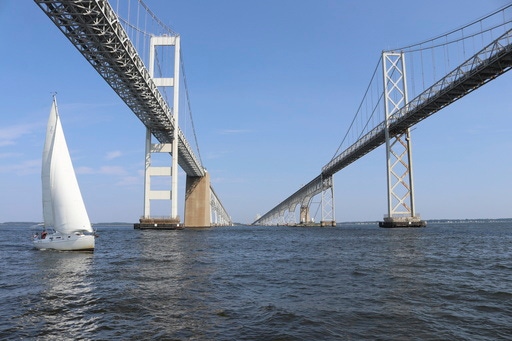Overall health of Chesapeake Bay gets best grade in more than 2 decades, annual report shows

A boat sails on the Chesapeake Bay under the Bay Bridge near Stevensville, Md., on Sunday, Aug. 20, 2023. The overall health of the Chesapeake Bay has received its highest grade since 2002 in an annual report released on Tuesday, July, 9, 2024: a C-plus. (AP Photo/Brian Witte)[ASSOCIATED PRESS/Brian Witte]
HARRISBURG, Pa. (AP) — The overall health of the Chesapeake Bay, the nation’s largest estuary, received its highest grade since 2002 in an annual report released by scientists Tuesday: a C-plus.
Scientists at the University of Maryland’s Center for Environmental Science made special note of Pennsylvania’s efforts to block pollution from entering state waterways.
Pennsylvania has faced criticism in the past for not doing enough to stop pollution from flowing into the bay, and the improved report comes after lawsuits accused Pennsylvania of failing to meet its obligations.
In a news conference overlooking the Susquehanna River, Pennsylvania Gov. Josh Shapiro credited years of efforts to help farmers prevent runoff laced with fertilizer from making it into waters that, like the Susquehanna, drain into the Chesapeake, and to upgrade municipal sewer systems that overflow into rivers during heavy rainfall.
Shapiro brushed aside a reporter’s suggestion that a C-plus is middling grade and said the focus should be on the commitment to improve.
“I think what we’ve seen here is not only a good grade for Pennsylvania, but real improvement. And you’re seeing a real commitment to being better,” Shapiro said.
Since 2019, Pennsylvania has spent about $1 billion on Chesapeake Bay restoration efforts, reduced nitrogen runoff from farms by 2 million pounds (907,200 kilograms) and planted 834 miles (1,342 kilometers) of natural buffers along waterways to prevent runoff, more than half of the watershed’s total planted in that time period, Shapiro said.
The health of the bay is a reflection of what’s happening across its six-state watershed, which includes Delaware, Maryland, New York, Pennsylvania, Virginia and West Virginia along with the District of Columbia.
“The Chesapeake Bay restoration is seen as a global model of sustainability. The Report Card shows that the results are moving in the right direction, but we need to pick up the pace of these efforts, particularly in light of climate change, which will make meeting the targets more difficult,” said Fernando Miralles-Wilhelm, president of UMCES, which compiles the report.
Bill Dennison, a UMCES professor and vice president, pointed out that the Upper Chesapeake Bay, which the Susquehanna flows into, has the second-highest score of the 16 bay regions measured in the report and continues to improve.
“Pennsylvania has been getting a bad rap for quite a while now, and we’ve got to stop playing the blame game, and start looking at the data and let the data guide us in our restoration efforts rather than pointing fingers,” Dennison said in an interview.
Adam Ortiz, the Environmental Protection Agency’s mid-Atlantic regional administrator, said there’s still work to do but the report shows progress.
“In recent years, EPA has stepped up enforcement, accountability, and investments and it is paying off. These efforts have helped spur historic results among upstream and downstream states and all sectors, especially agriculture,” he said.
This year’s UMCES report also is noteworthy because researchers said they are building a human-made debris indicator to understand the different types of contamination from items like plastic bags and bottles. Currently, not all of this debris is monitored, and the data is not collected uniformly across the bay and watershed. Researchers hope the information will be used to create targeted prevention and mitigation strategies.
“There’s a lot of things we can do on a personal-behavior level to reduce the plastics that end up in the bay,” Dennison said.
The report focuses on seven bay indicators that assess aquatic ecosystem conditions. Those include phosphorus and nitrogen measures in the water and how much oxygen is present at different depths. It also focuses on the condition of organisms living in or on the bottom areas of the bay, water clarity and aquatic grasses.
The report also focuses on bay watershed health, which includes ecological, societal and economic aspects, which aim to provide a more comprehensive view of the watershed. The watershed health scored 52%, or a grade of C, which is the same as the previous year.
Copyright 2024 The Associated Press. All rights reserved. This material may not be published, broadcast, rewritten or redistributed without permission.
